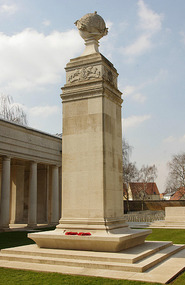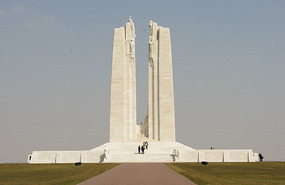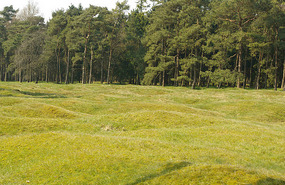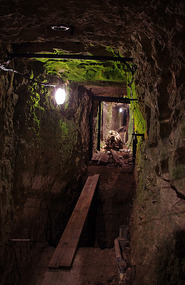We stopped off in Arras to visit the war memorial in town and to locate the name of Robert Smith Bennie. He was born August 18, 1896 in Chatham, Ontario. Prior to joining the Royal Flying Corp on July 4, 1916 he was a school teacher in Leamington, Ontario. He was lost on June 5, 1917 and is remembered on the wall at the Arras Memorial, which commemorates those who have no grave.
Robert's name was inscribed on a tall pillar, just as soon as you enter the memorial. The Flying Services Memorial commemorates over 1,000 men of the Royal Naval Air Service, the Royal Flying Corps and the Royal Air Force, who have no known grave. We looked around the memorial for a little while and then headed off to Vimy Ridge.
We started off by visiting the monument, which is a tribute to all Canadians who risked or gave their lives for freedom and peace in the First World War. The monument is enormous, resting on a bed of 11,000 tonnes of concrete, reinforced with hundreds of tonnes of steel. The monument itself is made of limestone and the figures adorning it were sculpted on site. The steps on the west side are flanked by a statues of a female and male mourner. On the east side, overlooking the Douai Plain, is the sorrowing figure of a woman that represents Canada – a young nation mourning here dead. Carved on the walls of the monument are the names of 11,285 Canadian soldiers who were killed in France and whose final resting place was then unknown. We walked around from the west side of the monument, around to the east, surveying the panels with thousands of names inscribed on them.
Standing next to the mourning statue on the west side, you get a clear view over the Douai plain and can see why it was such a strategic point to hold. At first, we thought that the Canadians had attacked from the plain. But upon seeing the pockmarked ground leading up to the monument, and the trenches on the west side, it was evident that they had attacked from the opposite side. We then walked down the steps on the east side and away from the monument to be able to see it in its entirety. It is an impressive monument in its simplicity and seems to capture a mixed sentiment: the taking of Vimy Ridge was a victory and highly symbolic, but the war was extremely costly for Canada, with 66,000 Canadian service personnel killed in the first World War.
The national historic site of Vimy Ridge sits atop Hill 145. This hill is the highest point on the 14 km long Vimy Ridge and during the war, it was a highly significant part of the German defence system. It was highly strategic earlier on in the war, but when the Canadians took the ridge in 1917, we learned that it wasn’t extremely significant in terms of being a strategic victory. It was however, a very symbolic and morale lifting victory for the Allied forces. It is often referred to as the moment when Canada, as a nation, was forged. This doesn’t downplay the considerable risk, planning, bravery and execution involved in taking the ridge. Two earlier attempts by the Allied forces had failed in 1914 and 15, resulting in heavy casualties, partly because the German defensive positions were highly fortified. "At daybreak on April 9, 1917, all four divisions of the Canadian Corps (aided by the British 5th Division and a considerable number of artillery units), fighting together for the first time, stormed the ridge. Preceded by a perfectly-timed artillery barrage, the Canadians advanced and, by mid-afternoon, had taken all their objectives except Hill 145, which was captured the following day.
The hard-fought victory was swift, but did not come without cost. Out of 10,602 casualties, 3,598 Canadians gave their lives". Some of the reasons why the Canadians succeeded when others had failed was due to the use of tactics by General Byng and Currie, that were considered radical at the time - they seem so perfectly logical and obvious that it is no surprise that so many lives were wasted under the command of other generals. Here are some of those “radical” tactics they used: gave nearly each of their soldiers a map of the area and ensured that they knew the objectives well in advance (as opposed to the morning of), trained for six months in advance and rehearsing the manoeuvres and timing expected in a near replica of the terrain, gave authority to frontline units and troops to make decisions on their own if separated from communications with headquarters.
After visiting the monument, we went over to the information center and were just in time for a guided tour of a part of the underground tunnels, subway and restored trenches. We walked about eight meters below ground level into a Canadian tunnel that ran for nearly two kilometers. We visited only about a hundred meters of the tunnel system but it definitely gave us an idea of what it would have been like. These tunnels were connected to the communication trenches in the rear and the front-line trenches. It was in these tunnels that a large number of the troops amassed, out of sight of the Germans, the night before the battle. These tunnels were also used to transport ammunition (shells, bullets) to the front line, conduct night raids, “eavesdrop” on the Germans by digging perilously close to their front lines, and to dig “subways”. We saw one of these original “subways”, which were essentially tunnels dug sometimes thirty meters deep, under the German lines, at the end of which mines were placed. The tunnels we walked through have all been reinforced with concrete today but originally, they were just carved out of the limestone and in some places, supported by wooden beams.
We saw the room where “runners” slept between communicating messages between the front and rear lines. We also got to see some original pumps from WWI that were used to supply fresh water to the tunnels and also glass isolators that held communications lines. These isolators kept the communication lines off the walls and from short-circuiting due to water. The guide at one point also turned off all the lights (except the emergency ones) to demonstrate how dim the tunnels would have been. We then headed back up and out of the tunnels, leading directly into one of the front-line trenches. We took a brief walk through the trenches and at one point, you could see the German front-line, only 10 meters away! With the tour completed, we toured the very informative visitor’s center for a while and then headed to our campsite for the evening.
Vimy Ridge
Monday, April 01, 2013
 Vimy, Nord-Pas-de-Calais, France
Vimy, Nord-Pas-de-Calais, France
Other Entries
-
102Cassoulet in Carcassonne
Feb 2634 days prior Carcassonne, Francephoto_camera19videocam 0comment 2
Carcassonne, Francephoto_camera19videocam 0comment 2 -
103Albi: Toulouse-Lautrec & amazing cathedral
Feb 2733 days prior Albi, Francephoto_camera15videocam 0comment 0
Albi, Francephoto_camera15videocam 0comment 0 -
104Bastides in the Lot
Feb 2832 days prior Cordes-sur-Ciel, Francephoto_camera24videocam 0comment 3
Cordes-sur-Ciel, Francephoto_camera24videocam 0comment 3 -
105Return to Rocamadour
Mar 0131 days prior Rocamadour, Francephoto_camera9videocam 0comment 0
Rocamadour, Francephoto_camera9videocam 0comment 0 -
106Market Day in Sarlat
Mar 0230 days prior Sarlat-la-Canéda, Francephoto_camera21videocam 0comment 1
Sarlat-la-Canéda, Francephoto_camera21videocam 0comment 1 -
107Marquessac Gardens
Mar 0329 days prior Vezac, Francephoto_camera29videocam 0comment 2
Vezac, Francephoto_camera29videocam 0comment 2 -
108Three "Plus Beaux Villages"
Mar 0428 days prior Domme, Francephoto_camera18videocam 0comment 0
Domme, Francephoto_camera18videocam 0comment 0 -
109A day for chores
Mar 0527 days prior Sarlat-la-Canéda, Francephoto_camera13videocam 0comment 1
Sarlat-la-Canéda, Francephoto_camera13videocam 0comment 1 -
110Relaxing in the Dordogne
Mar 0923 days prior Beynac-et-Cazenac, Francephoto_camera54videocam 0comment 2
Beynac-et-Cazenac, Francephoto_camera54videocam 0comment 2 -
111Prehistoric Art in the Dordogne
Mar 1121 days prior Les Eyzies-de-Tayac, Francephoto_camera15videocam 0comment 1
Les Eyzies-de-Tayac, Francephoto_camera15videocam 0comment 1 -
112Market Day in Brantome
Mar 1517 days prior Brantome, Francephoto_camera23videocam 0comment 1
Brantome, Francephoto_camera23videocam 0comment 1 -
113Chateau de Fontainebleau
Mar 1715 days prior Fontainebleau, Francephoto_camera53videocam 0comment 0
Fontainebleau, Francephoto_camera53videocam 0comment 0 -
114Chateau de Vaux-le-Vicomte
Mar 1913 days prior Vaux-le-Vicomte, Francephoto_camera51videocam 0comment 0
Vaux-le-Vicomte, Francephoto_camera51videocam 0comment 0 -
115Paris
Mar 275 days prior Paris, Francephoto_camera139videocam 2comment 2
Paris, Francephoto_camera139videocam 2comment 2 -
116WWI Museum in Peronne
Mar 284 days prior Peronne, Francephoto_camera41videocam 0comment 1
Peronne, Francephoto_camera41videocam 0comment 1 -
117"Van"dalism
Mar 293 days prior Peronne, Francephoto_camera3videocam 0comment 0
Peronne, Francephoto_camera3videocam 0comment 0 -
118Memorials of the Somme
Mar 311 day prior Albert, Francephoto_camera29videocam 0comment 0
Albert, Francephoto_camera29videocam 0comment 0 -
119Vimy Ridge
Apr 01 Vimy, Francephoto_camera26videocam 0comment 0
Vimy, Francephoto_camera26videocam 0comment 0 -
120Ypres and WWI Memorials
Apr 032 days later Ypres, Belgiumphoto_camera57videocam 0comment 0
Ypres, Belgiumphoto_camera57videocam 0comment 0 -
121Belgian Treats in Bruges
Apr 054 days later Brugge, Belgiumphoto_camera55videocam 0comment 0
Brugge, Belgiumphoto_camera55videocam 0comment 0 -
122More Belgian Treats in Ghent
Apr 065 days later Ghent, Belgiumphoto_camera28videocam 0comment 1
Ghent, Belgiumphoto_camera28videocam 0comment 1 -
123Moules in Dunkerque
Apr 076 days later Dunkerque, Francephoto_camera11videocam 0comment 1
Dunkerque, Francephoto_camera11videocam 0comment 1 -
124Côte d’Opal
Apr 098 days later Wimereux, Francephoto_camera14videocam 0comment 1
Wimereux, Francephoto_camera14videocam 0comment 1 -
125Van repaired and a visit to Brighton
Apr 1110 days later Brighton, United Kingdomphoto_camera16videocam 0comment 1
Brighton, United Kingdomphoto_camera16videocam 0comment 1 -
126Open Air Museum in Arnhem
Apr 1413 days later Arnhem, Netherlandsphoto_camera55videocam 0comment 2
Arnhem, Netherlandsphoto_camera55videocam 0comment 2 -
127Amsterdam
Apr 1716 days later Amsterdam, Netherlandsphoto_camera72videocam 0comment 2
Amsterdam, Netherlandsphoto_camera72videocam 0comment 2 -
128Aalsmeer Flower Auction
Apr 1817 days later Aalsmeer, Netherlandsphoto_camera47videocam 3comment 0
Aalsmeer, Netherlandsphoto_camera47videocam 3comment 0 -
129Cheese Market in Alkmaar
Apr 1918 days later Alkmaar, Netherlandsphoto_camera62videocam 0comment 0
Alkmaar, Netherlandsphoto_camera62videocam 0comment 0 -
130The Historic Triangle
Apr 2019 days later Hoorn, Netherlandsphoto_camera81videocam 2comment 3
Hoorn, Netherlandsphoto_camera81videocam 2comment 3 -
131Fishing Village of Marken
Apr 2120 days later Marken, Netherlandsphoto_camera21videocam 0comment 1
Marken, Netherlandsphoto_camera21videocam 0comment 1 -
132Edam, Tulips & Windmills
Apr 2221 days later Lisse, Netherlandsphoto_camera49videocam 0comment 1
Lisse, Netherlandsphoto_camera49videocam 0comment 1 -
133Canal Boating on the Bourgogne
May 0130 days later Migennes, Francephoto_camera110videocam 5comment 3
Migennes, Francephoto_camera110videocam 5comment 3 -
134Trapped by the Floods
May 0433 days later Fleurey-sur-Ouche, Francephoto_camera48videocam 1comment 0
Fleurey-sur-Ouche, Francephoto_camera48videocam 1comment 0 -
135Canal Boating on the Lateral Canal to the Loire
May 0938 days later Briare, Francephoto_camera99videocam 3comment 4
Briare, Francephoto_camera99videocam 3comment 4 -
136Dinan
May 1342 days later Dinan, Francephoto_camera42videocam 0comment 1
Dinan, Francephoto_camera42videocam 0comment 1 -
137Coastal Walk & Saint Malo
May 1443 days later Saint-Malo, Francephoto_camera21videocam 0comment 0
Saint-Malo, Francephoto_camera21videocam 0comment 0

 Vimy, Nord-Pas-de-Calais, France
Vimy, Nord-Pas-de-Calais, France





























2025-05-22